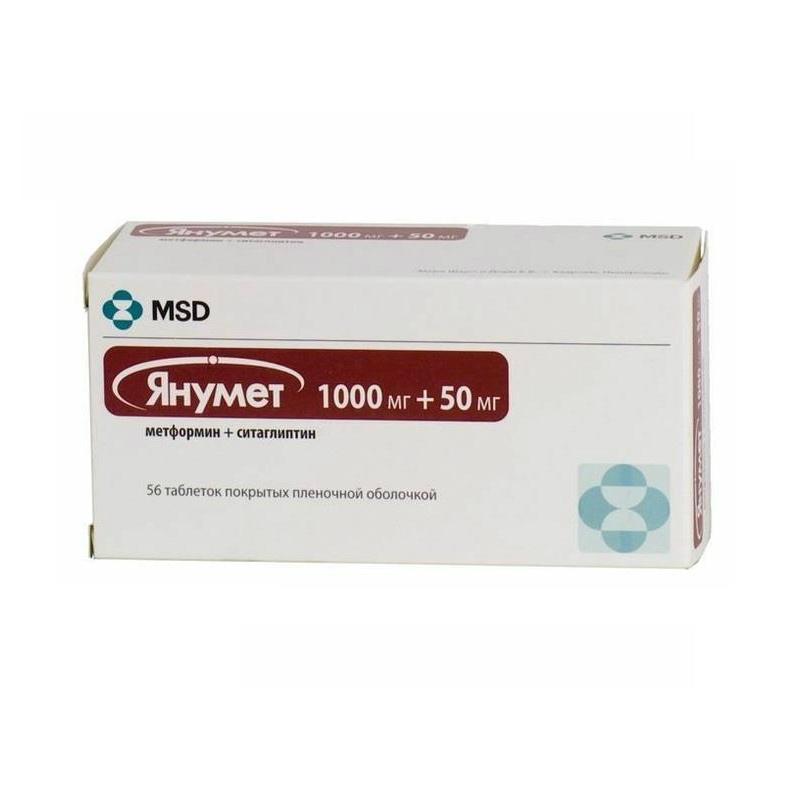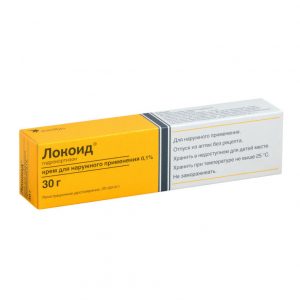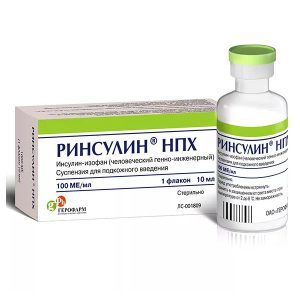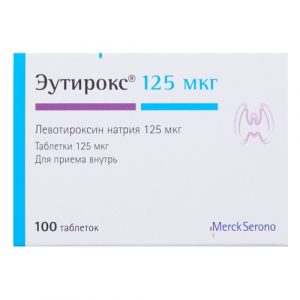Description
Latin name
Janumet
Release form
Tablets.
Packaging
56 pcs per pack.
Indications
Janumet is indicated as an addition to the diet and exercise regimen to improve glycemic control in patients with type II diabetes mellitus who have not achieved adequate control on the background of monotherapy with metformin or sitagliptin, or after unsuccessful combination treatment with two drugs.
Janumet is indicated in combination with sulfonylurea derivatives (a combination of three drugs) as a supplement to the diet and exercise regimen to improve glycemic control in patients with type II diabetes who have not achieved adequate control after treatment with two of the following three drugs: metformin, sitagliptin or sulfonylurea derivatives.
Janumet is shown in combination with PPAR- agonists (for example, thiazolidinediones) as an addition to the diet and exercise regimen to improve glycemic control in patients with type II diabetes who did not achieve adequate control after treatment with two of the following three drugs: metformin, sitagliptin, or PPAR- agonist.
Janumet is indicated for patients with type II diabetes mellitus (a combination of three drugs) as a supplement to diet and exercise regimen to improve glycemic control in combination with insulin.
Contraindications
Hypersensitivity to sitagliptin phosphate, metformin hydrochloride or to any other component of the
preparation. Acute conditions that can affect kidney function: dehydration, severe infections,
shock. Acute or chronic diseases that can lead to tissue hypoxia, which can lead to heart or respiratory failure, recent myocardial infarction, shock
Moderate or severe renal impairment (creatinine clearance
Impaired liver function
Acute alcohol intoxication, alcoholism
Period of breastfeeding
Diabetes mellitus type I
Acute or chronic metabolic acidosis, including diabetic ketoacidosis (with or without coma)
Radiological studies (intravascular administration of iodinated contrast agents).
Use during pregnancy and lactation
There were no adequately controlled studies of the drug Janumet or its components in pregnant women, therefore, there is no data on the safety of its use in pregnant women.
The drug Janumet, like other oral hypoglycemic drugs, is not recommended for use during pregnancy.
No experimental studies of the combined drug Janumet to evaluate its effect on reproductive function.
Only available data from studies of sitagliptin and metformin are presented.
Composition of
1 film-coated tablet contains:
Active ingredients:
Sitagliptin phosphate monohydrate 64.25 mg (equivalent to 50 mg sitagliptin) sminlp hydrochloride.
Excipients:
Microcrystalline cellulose 59, 30 mg
povidone 48.23 mg
sodium stearyl fumarate 13.78 mg
sodium lauryl sulfate 3.445 mg.
Shell of the Opadray II Pink tablet, 85 F 94203 (17.23 mg) contains:
Polyvinyl alcohol 47.800%
Titanium dioxide (E 171) 6,000%
Macrogol – 3350 23.500%
Talc 22.590%
Iron oxide 0.005%
Iron oxide red (E 172) 0.105%.
Dosage and administration of
Dosage regimen of the drug Janumet should be selected individually based on current therapy, effectiveness and tolerability, but not exceeding the maximum recommended daily dose of sitagliptin 100 mg.
The drug Janumet is usually prescribed 2 times a day with meals, with a gradual increase in dose, in order to minimize possible side effects from the gastrointestinal tract (GIT), characteristic of metformin. The initial dose of the drug Janumet depends on the current hypoglycemic therapy.
Side effects of
From the gastrointestinal tract: at the beginning of the course of treatment – anorexia, diarrhea, nausea, vomiting, flatulence, abdominal pain (decrease when taken with food) metallic taste in the mouth (3%).
From the cardiovascular system and blood (hematopoiesis, hemostasis): in rare cases – megaloblastic anemia (a result of malabsorption of vitamin B12 and folic acid).
From the side of metabolism: hypoglycemia in rare cases – lactic acidosis (weakness, drowsiness, hypotension, resistant bradyarrhythmia, respiratory disorders, abdominal pain, myalgia, hypothermia).
From the skin: rash, dermatitis.
Drug Interaction
Sitagliptin and Metformin
Simultaneous administration of multiple doses of sitagliptin (50 mg twice daily) and metformin (1000 mg 2 times daily) was not accompanied by significant changes in the pharmacokinetic parameters of metaphrin or metformin.
Studies of inter-pharmacological effects on the pharmacokinetic parameters of the drug Janumet have not been conducted, however, a sufficient number of similar studies have been conducted on each of the components of the drug, sitagliptin and metformin.
Sitagliptin
In studies with other medicinal products, sitagliptin had no clinically relevant effect on the pharmacokinetics of the following drugs: metformin, rosiglitazone, glibenclamide, simvastatin, warfarin, oral contraceptives. Based on these data, sitagliptin does not inhibit CYP isoenzymes of the CYP3A4,2C8 or 2C9 cytochrome system. In vitro data indicate that sitagliptin also does not inhibit CYP2D6,1A2,2C19 and 2B6 isoenzymes and does not induce CYP3A4. According to the population pharmacokinetic analysis of patients with type 2 diabetes, concomitant therapy had no clinically significant effect on the pharmacokinetics of sitagliptin. The study evaluated a number of drugs most commonly used by patients with type 2 diabetes, including: hypocholesterolemic drugs (statins, fibrates, ezetimibe), antiplatelet agents (clopidogrel), antihypertensive drugs (ACE inhibitors, antagonists of angiotensin receptors, angiotensin “Slow” calcium channels, hydrochlorothiazide, analgesics and non-steroidal anti-inflammatory drugs (naproxen, diclofenac, celecoxib), antidepressants (bupropion, fluoxetine, sertraline), antihistamines (cetirizine), proton pump inhibitors (omeprazole, lansoprazole) and dysfunctional drugs.
An increase in AUC (11%) as well as mean C max (18%) of digoxin when co-administered with sitagliptin was noted. This increase is not considered clinically significant, however, with the simultaneous administration of digoxin, monitoring of the patient is recommended. An increase in AUC and C max of sitagliptin was observed by 29% and 68%, respectively, with the combined single oral administration of the drug YANUVI at a dose of 100 mg and cyclosporine (a potent inhibitor of p-glycoprotein) at a dose of 600 mg. These changes in the pharmacokinetic parameters of sitagliptin are not clinically relevant.
Metformin
Glyburide – no changes in the pharmacokinetic and pharmacodynamic parameters of metformin were observed in the study of the inter-drug interaction of single doses of metformin and glyburide in patients with type 2 diabetes mellitus. Changes in AUC and Cmax of glyburide were highly variable. Insufficient information (single intake) and inconsistency of the plasma concentration of glyburide with the observed pharmacodynamic effects call into question the clinical significance of this interaction.
Furosemide – in a study of the inter-drug interaction of single doses of metformin and furosemide in healthy volunteers, a change in the pharmacokinetic parameters of both drugs was observed. Furosemide increased the concentration of C max of metformin in plasma and whole blood by 22%, metformin AUC in whole blood by 15%, without altering the renal clearance of the drug. The values of C max and AUC of furosemide, in turn, decreased by 31% and 12%, respectively, and the elimination half-life decreased by 32%, without significant changes in renal clearance of furosemide. There is no information on the inter-drug interaction of the two drugs with prolonged joint use.
Nifedipine – In a study of the drug-drug interaction of nifedipine and metformin, single-dose administration of healthy volunteers revealed an increase in plasma C max and AUC of metformin by 20% and 9%, respectively, and an increase in the amount of kidney metformin released. T max and the half-life of metformin have not changed. The basis is an increase in metformin absorption in the presence of nifedipine. The effect of metformin on the pharmacokinetics of nifedipine is minimal.
Cationic preparations – cationic drugs (ie amiloride, digoxin, morphine, procainamide, quinidine, quinine, ranitidine, triamterene, trimethoprim or vancomycin), secreted by tubular secretion, can theoretically interact with metformin, interact with metformin tubular transport system. Similar competition was observed with the concomitant administration of metformin and cimetidine by healthy volunteers in single and multiple dose studies, with a 60% increase in plasma C max and whole blood C max and a 40% increase in plasma and whole blood AUC. In the single-dose study, the half-life of metformin did not change. Metformin did not affect the pharmacokinetics of cimetidine. Although these drug interactions are mainly theoretical (with the exception of cimetidine), careful monitoring of the patient and dose adjustment of Janumet and / or the above cationic drugs excreted by the proximal renal tubules are recommended in their cases.
Some drugs have hyperglycemic potential and may interfere with established glycemic control. These include thiazide and other diuretics, glucocorticosteroids, phenothiazines, thyroid drugs, estrogens, oral contraceptives, phenytoin, nicotinic acid, sympathomimetics, slow calcium channel blockers and isoniazid. When administering these drugs to a patient receiving Janumet, careful monitoring of glycemic control parameters is recommended. Changes in the pharmacokinetic parameters of these drugs were not observed when co-administered with healthy volunteers of metformin and propranolol or metformin and ibuprofen.
Only a small proportion of metformin binds to plasma proteins, therefore, inter-drug interactions of metformin with drugs that actively bind to plasma proteins (salicylates, sulfonamides, chloramphenicol, and probenecid), are unlikely to occur, are unlikely,
Overdose
Sitagliptin: In healthy volunteers, single doses up to 800 mg were generally well tolerated. When used in a clinical study dose of 800 mg revealed a slight extension of the Q-Tc interval, which was not considered clinically significant. There is no experience of using the drug in doses exceeding 800 mg. The studies did not report adverse reactions associated with the dose of the drug, with 600 mg / day for 10 days and 400 mg for 28 days. Sitagliptin is poorly dialysable: according to clinical studies, only 13.5% of the dose was excreted during a 3-4 hour hemodialysis session. In case of clinical need, prescribe prolonged hemodialysis. There are no data on the effectiveness of peritoneal dialysis of sitagliptin.
Metformin: Metformin overdose was reported, including intake in excess of 50 g. Hypoglycemia was detected in approximately 10% of all overdose cases, however, no causal relationship to metformin overdose has been established. The development of lactic acidosis was reported in about 32% of all cases of metformin overdose. Emergency hemodialysis is required (metformin is dialyzed at a rate of up to 170 ml / min under good hemodynamics) to expedite excess metformin in the event of suspected overdose. In the event of an overdose of Janumet, standard supportive measures should be initiated: removal from the gastrointestinal tract of the drug that has not yet been absorbed, monitoring of vital signs, including ECG, hemodialysis, and prescribing supportive therapy if necessary.
Storage conditions
Store at a temperature not exceeding 25 ° C.
Expiration
2 years.
Active ingredient
Metformin, Sytahlyptyn
dosage form
dosage form
tablets
Akrikhin CPC AO, USA




